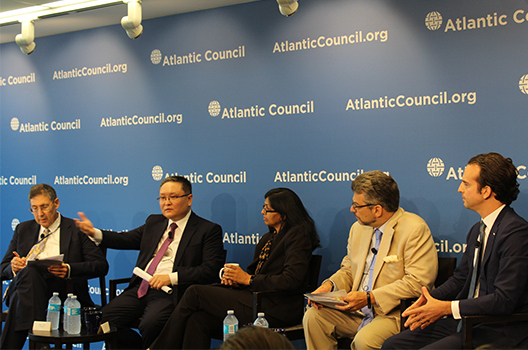 Fostering prosperity and security in Central Asia should be a priority for the Trump administration as the region’s economic and democratic potential increases, former assistant secretary of state for South and Central Asian affairs Nisha Biswal remarked at the Atlantic Council on July 18.
Fostering prosperity and security in Central Asia should be a priority for the Trump administration as the region’s economic and democratic potential increases, former assistant secretary of state for South and Central Asian affairs Nisha Biswal remarked at the Atlantic Council on July 18.
In previous years, the five Central Asian countries—Kazakhstan, Uzbekistan, Kyrgyzstan, Tajikistan, and Turkmenistan—were only seen through the lens of US needs in Afghanistan. This recently began to change, as “we saw in the last three years a great deal of attention being focused on Central Asia by… Russia, China, [and] certainly Iran,” said Biswal. She urged the current US administration to follow the lead of the other world powers and to focus more on Central Asia, encouraging increased engagement with Kazakhstan in particular.
Three other Central Asia experts participated in the discussion, agreeing with Biswal that Kazakhstan has been a model case of reform for the other former Soviet Socialist Republics to follow. Yerkin Akhinzhanov, Deputy Chief of Mission at the Embassy of Kazakhstan to the United States, Ariel Cohen, senior fellow of the Dinu Patriciu Eurasia Center at the Atlantic Council, and Catullus Helmer, former senior adviser to the prime minister of Kazakhstan joined Biswal on the panel entitled “Central Asia: US Foreign Policy at a Great Power Crossroads.” Ambassador John Herbst, director of the Atlantic Council’s Eurasia Center, moderated the discussion.
Though the panel addressed the Central Asian region as a whole, much of the conversation focused on Kazakhstan’s economic potential, particularly in the ever-growing green energy sector. Highlighting Kazakhstan’s economic reforms since gaining independence from the USSR, Helmer praised Kazakhstan for its “successful transformation,” resulting in two decades of 7% GDP growth.
“Throughout the former Soviet Union, with the exception of the Baltic States…Kazakhstan demonstrated for 25 years the best quality of leadership and of economic reform conceptualization and implementation,” Cohen agreed.
The optimism towards Kazakhstan’s reform progress was, however, collated by forebodings about continued development in the region. Because most of its GDP comes from oil and gas production and sales, Helmer warned of the “jeopardy of relying on natural resource based economy,” adding that the country is now “at a cusp.” Three out of four economies that grow as much as Kazakhstan usually get stuck in what Helmer called a “middle-income trap” due to a lack of foreign investment and technology advancements.
In order for Kazakhstan’s economic prosperity to continue in the coming years, it must undergo a “third modernization,” according to DCM Akhinzhanov. If Astana hopes to move Kazakhstan from a frontier market designation to a global market, it must further modernize its economy through alternative energy. Across the globe, companies are investing unprecedented amounts in clean energy developments. But in Kazakhstan, a country with the world’s second largest uranium reserves and huge potential for green energy production, investments are not pouring in to what Helmer estimated would be a $120 billion opportunity.
Biswal spoke toward the possible risks of such an investment in Central Asia. Problems such as currency convertibility, corruption, and government transparency inhibit further trade and investment in the region. A big question moving forward will be whether or not Kazakhstan can overcome these risks, attract foreign investors, and increase the pace of reform and opportunity to meet the population’s demand.
In spite of these risks, the panelists agreed that the Kazakh economy can continue to grow and progress as long as modernization is continued. This modernization can be achieved if the five Central Asian countries develop a “connectivity agenda,” said Biswal, “engag[ing] not just individually, but also holistically.” The United States has already helped to foster such collaboration through the joint initaitve C5+1, which boosted cooperation not only between Central Asia and the United states, but also between the Central Asian countries themselves.
According to Cohen, this initiative is not enough. As other world leaders become increasingly active in Central Asia, “[the US] profile over the last eight years in the region declined and continues to decline,” lamented Cohen. His advice to the Trump administration?—help breed cooperation so that no one hegemonic power can dominate the region.
The United States and other world leaders can only do so much to foster growth, however. As Helmer concluded, “history will be kind to Kazakhstan only if it continues to write it.”
Image: (L-R) Amb. John Herbst, DCM Yerkin Akhinzhanov, Nisha Biswal, Ariel Cohen, and Catullus Helmer discuss the economic and political situation in Central Asia and US foreign policy in the region.
